Table of Contents
- 🤔 What Are Carbon Filters?
- 🔎 What’s a Carbon Filter Made From?
- 🧐 How Do Carbon Filters Work?
- 📥 Types of Carbon Filters
- ❗️ Is Carbon in Water Filters Dangerous?
- 🧫 What Do Carbon Filters Remove From Water?
- 🔂 Carbon Filter Alternatives
- 🚰 When Should I Use An Activated Carbon Filter?
- 📆 How Often Should I Change My Carbon Filter?
- 📑 Final Thoughts
🤔 What Are Carbon Filters?
If you’re looking to buy a water filter for your home, there’s a high chance that it contains an activated carbon filter.
Carbon filters, known as either activated carbon or carbon block filters, use a process called adsorption to trap contaminants, allowing only smaller water particles to pass through their media.
They’re considered one of the most effective forms of water filtration, and are used in everything from portable water pitcher filters to whole house filters and countertop systems.
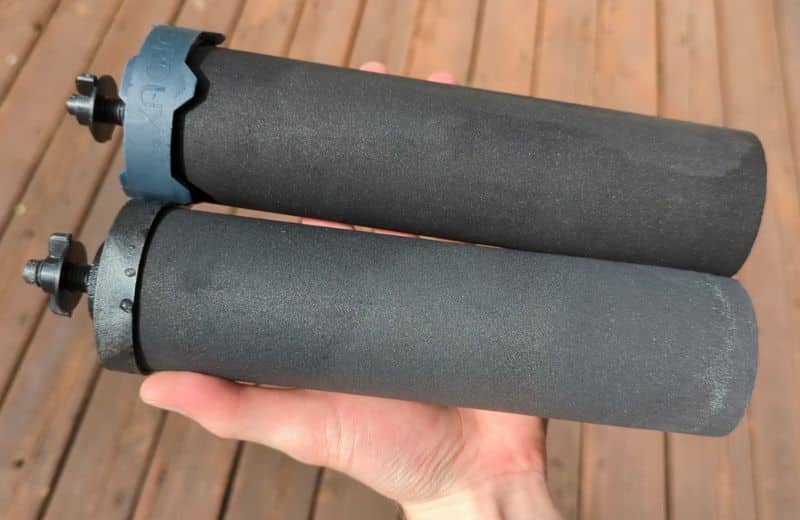
🔎 What’s a Carbon Filter Made From?
Carbon filters are made from raw materials, commonly coal (often referred to as activated charcoal filters) or coconut shell. These materials are naturally high in carbon, hence why they’re used to make carbon filters. The quality of the material used will greatly affect the quality of filtration – as will the material itself.
Coconut shell carbon is rapidly becoming a more and more popular choice of material for carbon filters because of several reasons:
- First, they’re a renewable resource, making them an environmentally friendly option;
- Second, they have a much higher percentage of micro-pores on their surface than carbon charcoal filters.
More micro-pores across the same surface gives more opportunity to trap a wide range of impurities, making coconut shell carbon a more effective filtration option for improving water quality.
Activated carbon filters are incredibly porous, which allows them to be as effective as possible at adsorbing (removing) contaminants from water. Not all activated carbon filters are created equal, and some will allow larger particles through that others will trap.
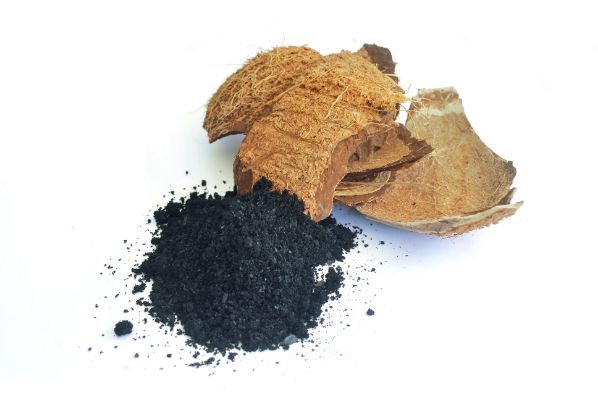
🧐 How Do Carbon Filters Work?
To learn how activated carbon filters water, we just need to understand the process of adsorption. This is a 2-in-1 process: large contaminants are trapped in the tiny pores, while the carbon material binds to the smaller contaminants, preventing them from being able to pass through the pores with the water particles.
To pass through the filter, water needs some force – whether it be the force of gravity, or the force of water pressure when you turn on your faucet.
However, most activated carbon filters require a relatively low water pressure in order for the filter to work the most effectively – too high and water won’t have enough contact time with the filter.
It’s also important that activated carbon filters are used with cold water, which makes them more effective than with warm water – and too much heat is a big no-no, as when hot water flows through the system, it can damage the media.
Eventually, the ability of a carbon filter to bind to, and remove, contaminants is used to max capacity, and the filter needs to be changed. There are general guidelines offered by activated carbon filter manufacturers to let you know how often the filter needs to be changed, but the frequency of this maintenance duty depends on your home’s contaminant levels and your personal water use.
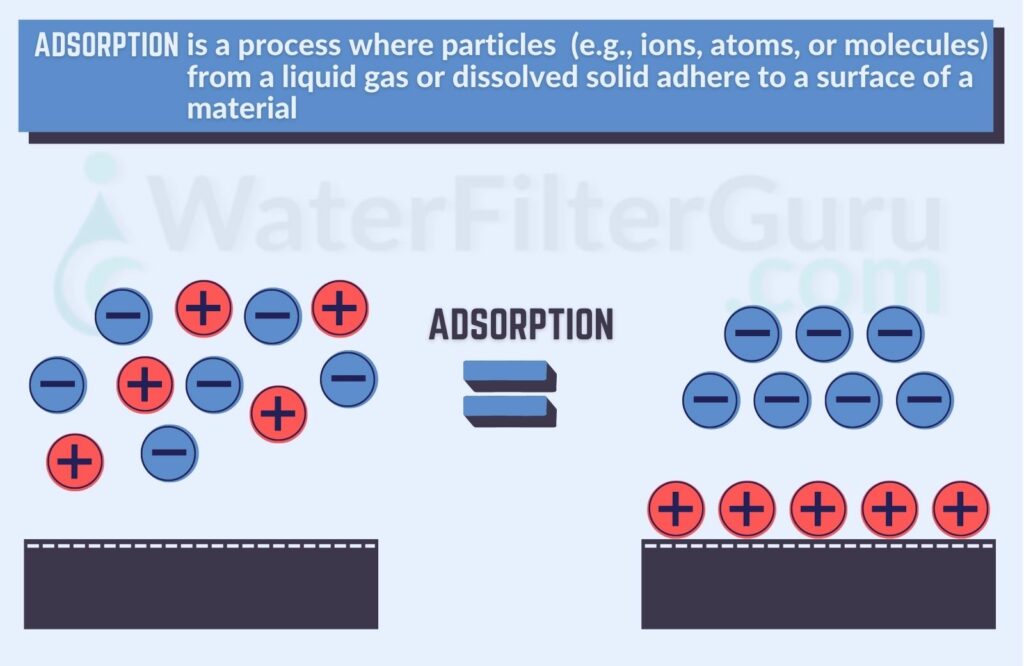
📥 Types of Carbon Filters
Granular activated carbon (GAC) filters
Granular activated carbon filters, otherwise known as GAC filters, are made up of loose carbon particles. They tend to have a smaller surface area than carbon block filters, making them slightly less effective when it comes to their overall capacity for contaminant removal.
When water flows through a granular activated carbon filter, its contact time with the filter is lower than with carbon block. This means you can benefit from higher flow rates with a GAC water filter, which is particularly a benefit with gravity filtration systems.
However, this does mean that more contaminants are likely to remain in the water as a result. Longer contact time equals a more thorough filtration. GAC filters remove contaminants like chlorine taste and smell, VOCs and heavy metals. They don’t have a limit when it comes to pore size, as the filters GAC that are used are highly porous.
Carbon block filters
Activated carbon block filters are formed by blocks of compressed carbon rather than loose particles. This gives them a large surface area, enabling them to trap a broader range of contaminants across their media. As a result, water has a longer contact period with carbon block filters, which is again a benefit, giving more time for the majority of contaminants to be removed.
Carbon block filters are used to remove organic contaminants, and organic chemicals that give water a bad taste and odor.
Activated carbon block filters can have a pore size ranging from as small as 0.5 microns to as large as 10 microns. Generally, the smaller the pore size, the better the impurity removal, but one issue with a smaller sized activated carbon media is that flow rate may be affected as even the smaller water particles will have trouble passing through.
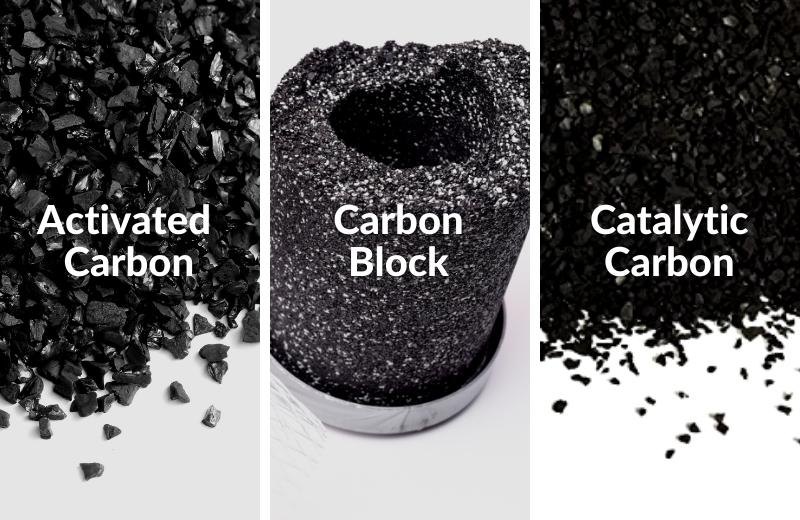
Catalytic carbon
You may also hear of some filtration systems that use catalytic carbon, instead of activated carbon. Catalytic carbon is activated carbon that has been modified to be able to remove hydrogen sulfide (the colorless gas that smells like rotten eggs). If you know by smelling your water that it contains high concentrations of this contaminant, you’ll benefit from this type of filter.
Read Our Reviews:
❗️ Is Carbon in Water Filters Dangerous?
You might be wondering, when you’re trying to remove impurities from your tap water, why would you use a material that could also be considered an impurity? And because of this, are carbon water filters safe? Or are they better off avoiding? This may especially seem like a potential issue to you if you’ve noticed carbon flecks or “dust” in your water when first getting started with a carbon filter.
The good news is, carbon is a completely harmless material that occurs naturally in coconut shell and coal, both of which are organic matter that you can actually buy in supplement form for health purposes (fun fact: they’re used to treat digestive issues, and coal can even be used as an emergency medication for poisoning). So it won’t hurt you to ingest carbon – though you might want to flush your filter for a little longer if you’re noticing carbon flecks in your water, which should clear them out.
🧫 What Do Carbon Filters Remove From Water?
Activated carbon removes a number of specific contaminants from drinking water, including:
- Organic chemicals like chlorine tastes and odors
- Volatile organic compounds (VOCs)
- Heavy metals like lead
- PFOS (perfluorooctanesulfonic acid)
- Trihalomethanes (THMs)
- Pesticides & herbicides
Because all carbon filters use the same concept of adsorption, no two filters should vary massively in the contaminants each filter removes.
Note that unless a carbon filter is combined with another water filtration media, it won’t be capable of removing minerals, salts, fluoride, bacteria or viruses. Activated carbon won’t completely remove a huge range of contaminants, though it can reduce between 60 and 80 impurities, which is a pretty impressive number. It’s also at an advantage when it comes to pesticide removal, with activated carbon filters currently being the only type to remove all 14 listed pesticides, according to the EPA.
Activated carbon filters are best known for removing the impurities that are most commonly found in tap water – hence why chlorine, which is used to disinfect water during the treatment process, is so often mentioned in relation to activated carbon.
🔂 Carbon Filter Alternatives
Reverse Osmosis
One of the most popular water filtration methods, which is much more effective than activated carbon water filters when it comes to contaminant removal, is reverse osmosis. This filtration process may include an activated carbon filter as one of multiple stages of filtration, which are combined together to provide the most thorough water treatment solution possible.
Included in a reverse osmosis filter is an RO membrane, which is a semi-permeable membrane that contains pores so tiny that only the smallest water particles can pass through, while contaminant-rich wastewater is flushed down the drain. Reverse osmosis can remove chlorine and heavy metals, like carbon filtration – but it can also remove a whole host of contaminants that activated carbon filtration can’t remove, like fluoride, bacteria, and arsenic.
KDF Filters
KDF filters, or Kinetic Degradation Fluxion filters, improve water quality using a process called redox. In this process, electrons in the media are swapped with contaminants, like chlorine, iron, lead, mercury, and hydrogen sulfide. Redox also contributes to a reduction in algae, bacteria, fungi and limescale.
KDF is usually used in combination with other types of filtration, such as a pre- or post-filtration stage before or after a whole home filter, which commonly uses an activated carbon filter. It may also be used in conjunction with well water systems. The only contaminants that both KDF and activated carbon filters remove are chlorine and lead; you can enjoy a more thorough contaminant removal when using both KDF and activated carbon filtration together.
Sediment Filters
Sediment filters are commonly used as the very first stage of filtration, for reverse osmosis water systems, whole house point of entry systems, water softeners/ conditioners, and more. The purpose of a sediment filter is to extend the life of a system’s filters – including carbon block or activated carbon water filters. It does this by trapping larger sediment like sand, dust and rust when tap water passes through, preventing it from being able to get into the system and clog up a filter with smaller pores, rendering it ineffective almost immediately.
You could never use a sediment filter on its own, as these filters have a minimum 5 micron size – they are usually 10 or 15 microns. This means that, while the filter will capture and remove suspended particles in water, it won’t be able to remove smaller contaminants that are tiny enough to pass straight through these larger pores. It’s best used before an activated carbon filter, and occasionally it’s also used after filtration.
🚰 When Should I Use An Activated Carbon Filter?
There are activated carbon filters of all sizes, to fit multiple water purification systems, so there’s no limit to how, and for what purpose, you can use one of these filters. If you’re looking for a water treatment solution for your whole home, opt for a point of entry filter system that features one or more activated carbon filters as part of its filtration process. If you just need clean drinking water, under sink systems or countertop units that contain activated carbon filters will do the trick. You can even buy water pitchers that feature activated carbon filters, if you’re looking for the most portable and easy to use water filtering solution.
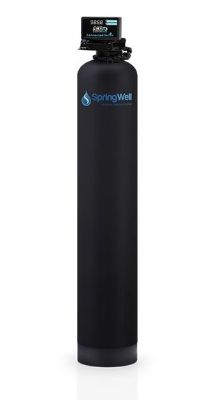
Let’s take a look at when you should use activated carbon filters in terms of contaminant removal.
You should use an active carbon filter, whether that’s a GAC or a carbon block filter, if you’re looking to remove chlorine bad tastes and odor from your drinking water. Water treatment systems that use activated carbon are highly effective at chlorine removal, with most being NSF certified in the United States for carrying out the job to a high quality.
An activated carbon filtration system may also be certified for additional contaminant removal, such as the reduction or removal of lead. If your home’s plumbing is old, it may use lead pipes, which are known to corrode and leak lead into your drinking water. This may also be the case with your city water pipes that bring drinking water into your home, which may also be made from lead.
Finally, if you have volatile organic compounds in your water (VOCs), as the majority of US households do, you can use an activated carbon filter to make sure the majority of VOCs are removed for safer drinking.
The most obvious improvement you’ll see from activated carbon filters is the reduction of bad tastes in water. While they can’t completely eliminate a whole range of contaminants, activated carbon filters can get rid of a good selection of common contaminants found in US municipal water sources.
📆 How Often Should I Change My Carbon Filter?
To ensure an activated carbon filter continues to work to a high quality, you need to change the filter regularly. Carbon activated filters can only adsorb so many contaminants. Whether it be chlorine, lead or VOCs, these contaminants merge together on the surface of the filter media and begin to clog the surface. After so much adsorption, the surface will eventually become so clogged that water flow rate is affected, which means you’ll have to wait much longer to gain access to clean drinking water.
Once the whole surface area of a carbon activated filter is covered, it leaves no more room for adsorption to take place. This means that contaminants like chlorine will simply pass through the filter with the water.
How often you need to change your activated carbon filter depends on several factors, including the quality of the filter, its surface area, the contaminant density of your tap water, and your daily water usage. Of course, the higher the volume of water that passes through your filter on a daily basis, the faster the surface will become saturated with impurities. The same goes for your contaminants – the more contaminants per gallon of water, the more adsorption will take place; the quicker the surface area of the filter media will become clogged up. A higher quality filter will generally last longer, as will a filter with a larger surface area that has more space to adsorb contaminants.
Most activated carbon filters last between 6 months and one year for a point of use and an average of 3 years on point of entry. While some filters have a smart indicator that will let you know when it’s time to change them, you should be able to spot the signs of a filter that needs changing without this. If the tap water that flows through your filter has taken on an unpleasant taste or odor, it’s evidence that the filter is no longer providing sufficient water treatment. A decrease in flow rate is another sign, especially if usually water flows at a speed that isn’t noticeably slow.
📑 Final Thoughts
Whether you opt for a GAC filter or a carbon block filter, you can be pretty certain that it’s going to do a good job at water treatment for your home. The use of activated carbon for filtration of drinking water is still celebrated today as being highly effective, and many filters are supported by third-party testing and certifications to prove their contaminant removal capabilities.
It can be tricky getting your head around the different types of activated carbon filters, and deciding on which is best for you. A good starting point is to make sure that your activated carbon filter of choice is NSF certified and a favored water filtration system amongst customers.
Activated carbon filters remove one of the biggest issues in tap water: chlorine. They are so popular that they’re relatively affordable, with healthy competition between brands giving us, the consumer, plenty of products to choose from. As a form of water purification, they might not be the most thorough, but these filters work very well at the job they’re intended to do. To make them even more effective, they’re often placed alongside other filters in whole home and under sink water systems, to remove a much broader range of contaminants than just chlorine, lead and VOCs.
